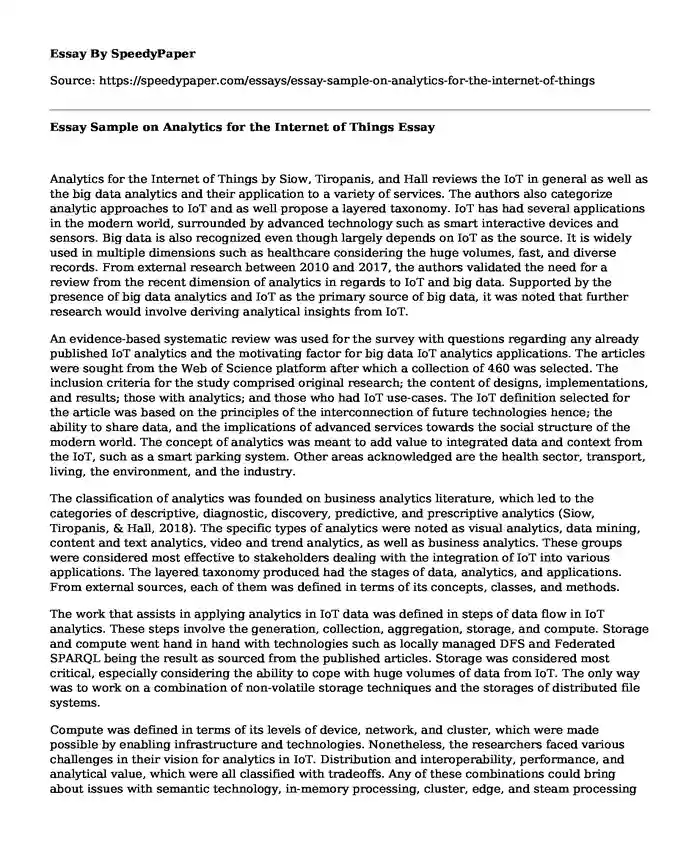
| Type of paper: | Article review |
| Categories: | Psychology Justice Community |
| Pages: | 3 |
| Wordcount: | 607 words |
Analytics for the Internet of Things by Siow, Tiropanis, and Hall reviews the IoT in general as well as the big data analytics and their application to a variety of services. The authors also categorize analytic approaches to IoT and as well propose a layered taxonomy. IoT has had several applications in the modern world, surrounded by advanced technology such as smart interactive devices and sensors. Big data is also recognized even though largely depends on IoT as the source. It is widely used in multiple dimensions such as healthcare considering the huge volumes, fast, and diverse records. From external research between 2010 and 2017, the authors validated the need for a review from the recent dimension of analytics in regards to IoT and big data. Supported by the presence of big data analytics and IoT as the primary source of big data, it was noted that further research would involve deriving analytical insights from IoT.
An evidence-based systematic review was used for the survey with questions regarding any already published IoT analytics and the motivating factor for big data IoT analytics applications. The articles were sought from the Web of Science platform after which a collection of 460 was selected. The inclusion criteria for the study comprised original research; the content of designs, implementations, and results; those with analytics; and those who had IoT use-cases. The IoT definition selected for the article was based on the principles of the interconnection of future technologies hence; the ability to share data, and the implications of advanced services towards the social structure of the modern world. The concept of analytics was meant to add value to integrated data and context from the IoT, such as a smart parking system. Other areas acknowledged are the health sector, transport, living, the environment, and the industry.
The classification of analytics was founded on business analytics literature, which led to the categories of descriptive, diagnostic, discovery, predictive, and prescriptive analytics (Siow, Tiropanis, & Hall, 2018). The specific types of analytics were noted as visual analytics, data mining, content and text analytics, video and trend analytics, as well as business analytics. These groups were considered most effective to stakeholders dealing with the integration of IoT into various applications. The layered taxonomy produced had the stages of data, analytics, and applications. From external sources, each of them was defined in terms of its concepts, classes, and methods.
The work that assists in applying analytics in IoT data was defined in steps of data flow in IoT analytics. These steps involve the generation, collection, aggregation, storage, and compute. Storage and compute went hand in hand with technologies such as locally managed DFS and Federated SPARQL being the result as sourced from the published articles. Storage was considered most critical, especially considering the ability to cope with huge volumes of data from IoT. The only way was to work on a combination of non-volatile storage techniques and the storages of distributed file systems.
Compute was defined in terms of its levels of device, network, and cluster, which were made possible by enabling infrastructure and technologies. Nonetheless, the researchers faced various challenges in their vision for analytics in IoT. Distribution and interoperability, performance, and analytical value, which were all classified with tradeoffs. Any of these combinations could bring about issues with semantic technology, in-memory processing, cluster, edge, and steam processing (Siow, Tiropanis, & Hall, 2018). Even with these, the review was successful, and IoT was noted to have the potential of being applied in an array of services that are technologically advanced.
Reference
Siow, E., Tiropanis, T., & Hall, W. (2018). Analytics for the Internet of Things: A survey. ACM Computing Surveys (CSUR), 51(4), 74:1-36.
Cite this page
Essay Sample on Analytics for the Internet of Things. (2023, Feb 14). Retrieved from https://speedypaper.com/essays/essay-sample-on-analytics-for-the-internet-of-things
Request Removal
If you are the original author of this essay and no longer wish to have it published on the SpeedyPaper website, please click below to request its removal:
- Essay Sample Highlighting Business Negotiation Process in a Multicultural Context
- Free Essay Example on Punishment Rate of Child Sexual Offenders in the USA
- Defining a Business Cycle. Free Essay Sample.
- How Does Religion Affect Individuals and Society? Essay Example
- Essay Example on Analysis of "The Madonnas of Echo Park"
- Essay Sample on Critique of Online Ostracism Affects Children Differently
- Essay Sample on Data Warehousing
Popular categories




